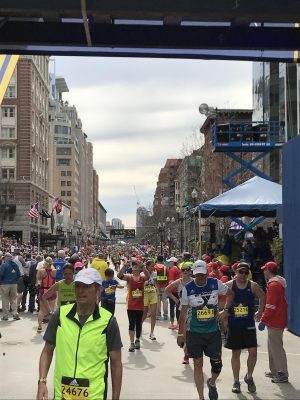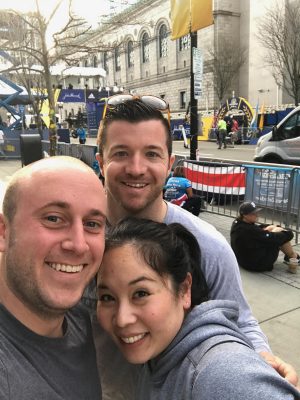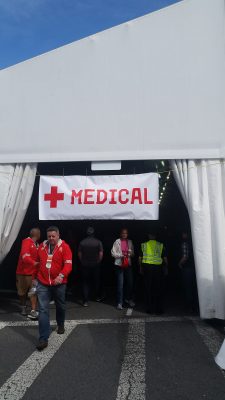William M. Adams, PhD, ATC Vice President of Sport Safety
Robert A. Huggins, PhD, ATC Vice President of Research and Vice President of Athlete Performance and Safety

April 17, 2017 was the 121st running of the Boston Marathon, a race considered by many as the world’s most elite marathon drawing over 30,000 participants in the 26.2-mile trek from Hopkinton, MA to Boylston Street in downtown Boston. This years’ race was warmer (70-75°F) than the average year, thus resulting in a greater number of runner’s seeking medical care during or following the completion of the race. In total, ~2,400 runners were treated in medical tents both at the finish and along the course throughout the day ranging from minor issues (muscle cramps, dehydration and musculoskeletal injuries) to more severe injuries such as exertional heat stroke and hyponatremia. As a result of the heat, 20-25 runners were treated for exertional heat stroke (EHS) both on the course and at the finish line. Why so many EHS’s you might ask? Well given the time of the year (April) and provided that many runners training throughout the winter months have limited heat exposure during training, there is a greater risk of exertional heat stroke when environmental conditions become warmer than average conditions, which was evident at this year’s race.
For KSI’s William Adams, PhD, ATC and Robert Huggins, PhD, ATC, it was their 6th time being part of the medical staff that volunteers their time on Marathon Monday to assist the runners in need of medical care. Below is a reflection from both Dr. Adams and Dr. Huggins on their experiences at this year’s race and from their previous years as medical volunteers

Dr. Adams’ Perspective
For the 2017 Boston Marathon, I was assigned to the finish line chute, which is located from behind the finish line to the medical tent in front of Boston Public Library. I was responsible for observing the finishers crossing the finish line and identifying those runners who were injured or suspected of having potential issues (e.g. exertional heat stroke). In previous years, I have worked in the medical tents located at finish line, so this year was a new experience for myself as a clinician as I transitioned from treating runners triaged to the medical tent to identifying runners in need of medical care upon finishing the race.
Overall, the Boston Marathon is an amazing experience and it has been a privilege to work alongside great clinicians over the past 6 years. It is a gratifying feeling having runners stop after finishing the race and thanking you for being there and making their race experience the best it can be. Marathon Monday also has special meaning for myself personally as I met my now wife 6 years ago at the race as we both volunteered to be a part of the medical staff in 2011.
For clinicians wanting to get a sense of what it is like to provide medical care at a mass participation event, I would strongly encourage anyone to sign up to volunteer for the Boston Marathon and get to experience what the world’s best marathon has to offer.
Dr. Huggins’ Perspective
Every year on Partriot’s Day I wake up at 4:00 am and drive with some of my colleagues to Boston, MA to volunteer my services in the finish line medical tent at the Boston Marathon. Each year I am amazed at the sheer number of medical professionals who gather to be there for the runners. Hundreds of healthcare professionals, students, and volunteers work together to provide care to thousands of runners for approximately 6 hours. The entire team is under the direction of the BAA Medical Directors (Chris Tryanos, ATC, Pierre d’Hemecourt, MD, Aaron Baggish, MD, and Sophia Dyer, MD). Every year, myself and all of the other medical professionals show up at 6:00am, get our credentials, head to the medical meeting, assemble with our respective group leaders for our assignments (Lawrence Venus for the Athletic Trainers), get our lunch, and report to our sections. This year I had a little time to spare before reporting to the medical tent and took a moment to visit one of the bombing sites near the finish on Boylston Street. Attached to the tree nearest the site, (see image) there was a memorial on the tree to remind those of the tragedy that happened back in 2013. Although I was not present in the medical tent that year, I was so proud of how my fellow Athletic Trainers and the other medical professionals responded to that emergency. Each year we are reminded of that tragic event and certainly it is in the back of our minds, but each year since, we push on for if we dwell on that day and live in fear, “they” win and “they” WILL NEVER WIN! #BOSTONSTRONG

My first 3 years I worked in Medical Tent A, however for the past 3 I have had the honor of working in Medical Tent B on the heat team. Good ole’ section 19! This year was like the rest in that my primary responsibility was to assist in the administration of the cold-water immersion treatment for any runners whose core body temperatures exceeded 104°F. Given the number of EHS patients is not nearly that experienced in Med Tent A, in addition to being on the heat team, my section also provided care in a similar fashion to the other sections of the tent. I had the honor of working with two fantastic nurses, two physical therapists, and a medical student in charge of documentation. Each year I meet new people and it is always a great experience. Although, the weather this year brought more dehydrated, slightly hyponatremic (low blood sodium), and muscle cramping athletes our way than years past, it was another successful day in Boston and I strongly encourage anyone who is interested in working the medical tent to volunteer and come see a side of the marathon that most don’t even know about. I promise it will be an experience that you will always remember!
